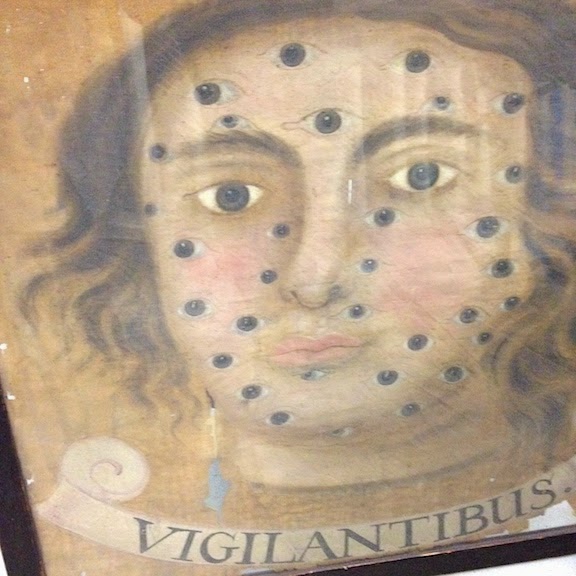My visit to the Massachusetts Historical Society last week was not all lovely gowns. Anne E. Bentley, Curator of Art & Artifacts, had this military standard, or banner, to show us, too. Because the standard is now preserved behind glass, it was difficult to photograph, so I'm including the black-and-white image from the Society's collection for the overall view, and the iPhone photos so you can see that he's blue-eyed (all of them) and pink-cheeked.
Painted on both sides on silk that has split in places, the standard features a man's disembodied head that belongs in a Wes Craven movie. At first glance, the face appears to be covered with spots, but if you look more closely, you'll see that those spots are eyes. I counted over 30 of them, eyes that are complete with curling eyelashes and looking up, down, and sideways. Beneath the face is emblazoned "Vigilatibus", Latin for be vigilant, or watchful, which would certainly be easier with all those eyes.
The mystery: no one today is quite sure of the standard's history or allegiance. Here's the MHS catalogue description:
A framed painted silk standard, double-sided, of a face with multiple eyes, believed by the donor to have been taken by British or Colonial New England forces from the French during the period 1756-1763. Efforts to substantiate this information have been unsuccessful. Given by Walter Gilman Page on July 14, 1900.
In other words, while Mr. Page made his gift (no doubt purposefully) on Bastille Day, Vigilantibus might have flown as a banner over French, British, or colonial American troops. Regardless of the the standard's owners, it certainly would have made an impression glimpsed through the smoke of battle or rising up in the New England woods during the French & Indian War.
So here's the mystery for our ever-knowledgeable readers around the world. Have any of you ever come across an 18th c. British or French regiment or military organization with "vigilantibus" as its slogan? Have you ever seen a similar many-eyed man in an 18th c. print or painting that might have inspired the banner? If you have, please let us know. After all, he's watching.
Once again, many thanks to Anne E. Bentley and the Massachusetts Historical Society.
Above: Vigilantibus standard, silk, 18th c. From the Collections of the Massachusetts Historical Society.
Below: Vigilantibus standard, photograph ©2015 by Kimberly Alexander.



 One of us --
One of us -- 



8 comments:
'vigilantibus'is an adjective used as a noun (dative or ablative plural)and not a verb.
If you google the word, you find several versions of a Latin tag meaning 'the laws serve the vigilant, not those who sleep'.
These words would seem to be more suitable to the American rebels. Wasn't their beef that their rights were not respected?
http://legal-dictionary.thefreedictionary.com/Vigilantibus+et+non+dormientibus+serviunt+leges
Interesting, but also rather unpleasant. It's the kind of image that could give a child (or even a nervous adult) nightmares.
Harkens back to Greek mythology and Argus, the giant who was covered with 100 eyes...
Argos is the many-eyed watchman, servant of Hera in Greek mythology, set to watch Io. Possible connection?
Best regards,
Zena Herbert
Found a reference to name on bldg in Edinburgh in 18th c.
https://books.google.com/books?id=4KdAAQAAMAAJ&pg=PA413&lpg=PA413&dq=vigilantibus%2018th%20century&source=bl&ots=KzPXYJ-fr0&sig=oAy6D56ecY7fKOxcWQlMDp55ccc&hl=en&sa=X&ei=u9JHVbPTNcWKsAWH8ICIBg&ved=0CDcQ6AEwBw#v=onepage&q=vigilantibus%2018th%20century&f=false
Also from Aspery catalog:
Baker, Sir Richard.
A cHRONIcLE OF tHE KINGS OF ENGLAND.
From the Time of the Romans Government Unto the Raigne of Our Soveraigne Lord King Charles. Containing All Passages of State & Church, with All Other Observations Proper for a Chronicle. Faithfully Collected Out of Authours Ancient and Moderne; & Digested into a New Method. By Sir R. Baker, Knight.
London, 1643. First edition. Folio. Engraved title and frontispiece. Binding of late 17th / early 18th century brown calf boards, gilt stamp of crest (a cock standing on a trumpet) and motto on both covers ‘Vigilantibus’ (Acheson or Gosford families), corners bumped, spine rebacked and endpapers replaced. £2,600 http://www.asprey.com/.../Fine_and_Rare_Books_2010.pdf
Head of Argus, slain by Mercury?
I'm researching the history of a historical home I recently purchased in Massachusetts and came across a textbook that references a similar (if not the same) standard that was believed to be taken from the French during the French and Indian War and maintained in the family of Captain Benjamin Williams.
https://books.google.com/books?id=UgoWAAAAYAAJ&pg=PA390&lr=&source=gbs_toc_r&cad=3#v=onepage&q=%22benjamin%20williams%22&f=false
Hope this helps!!
Post a Comment